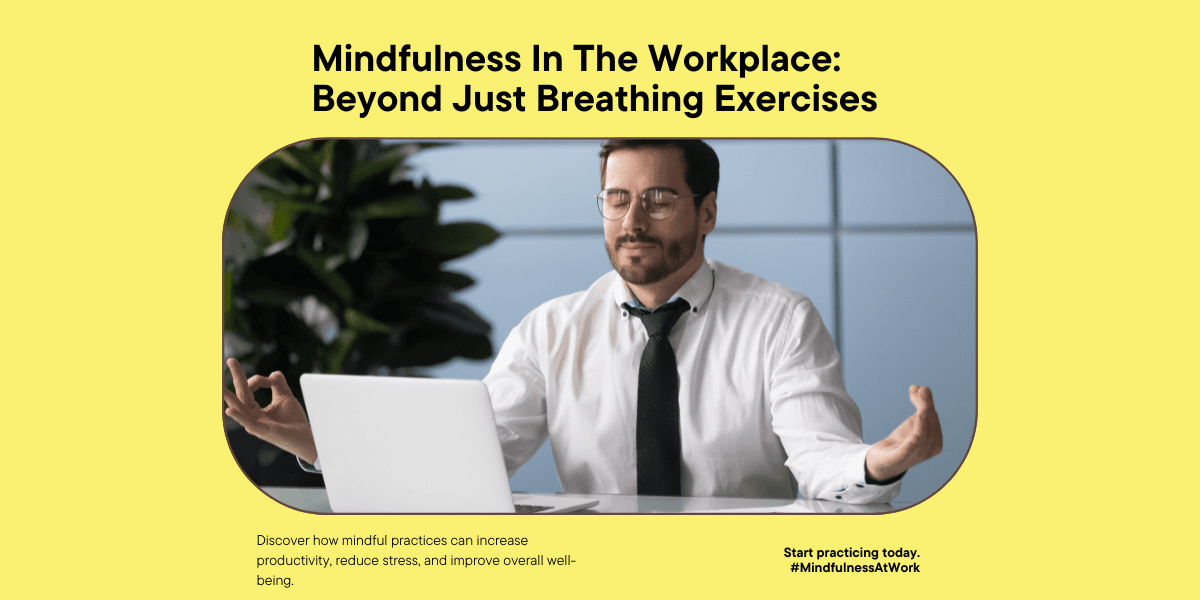Mindfulness In The Workplace: Beyond Just Breathing Exercises

Introduction
Mindfulness is an increasingly popular trend in the workplace, with many organizations promoting it as a way to boost productivity, reduce stress and improve overall well-being. However, despite its popularity, mindfulness in the workplace is often reduced to simple breathing exercises, meditation sessions, or short breaks to focus on the present moment. While these practices can certainly be beneficial, they may not be enough to truly integrate mindfulness into the workplace culture and achieve its full potential. In this article, we will explore some of the aspects that are often missing from mindfulness in the workplace, and how to address them.
Lack of structure:
Mindfulness in the workplace is often seen as a personal or individual practice that employees are expected to implement on their own, without any structured training or guidance. This can make it difficult for employees to integrate mindfulness into their work routine and to make it a habit.
Focus on the present moment:
While mindfulness is all about being in the present moment, it is also important to consider future-oriented thinking. This means that while mindfulness should be used to help employees stay focused and grounded at the moment, it should also be used as a tool to help employees anticipate and plan for future challenges.
Ignoring the social aspect:
Mindfulness is often seen as an individual practice, but it also has a significant social aspect. This means that while it is important to develop mindfulness as an individual practice, it is equally important to incorporate it into team dynamics and interactions in the workplace.
Over-reliance on meditation:
Meditation is a key component of mindfulness, but it is not the only aspect. Mindfulness also involves paying attention to thoughts, feelings, and body sensations and practicing self-compassion. By focusing solely on meditation, mindfulness in the workplace can miss out on other critical components that can make it more effective.
Ignoring the impact of the work environment:
The work environment can have a significant impact on employee well-being and stress levels. By ignoring this aspect of the work experience, mindfulness in the workplace can be limited in its effectiveness.
Conclusion
while mindfulness has many benefits in the workplace, it is important to consider these missing elements to make it a more effective tool for improving employee well-being, productivity, and performance. By incorporating structured training, considering future-oriented thinking, incorporating the social aspect, practicing self-compassion, and taking into account the work environment, companies can make mindfulness a more impactful practice for their employees.
Related Articles

Letting Go With Grace: Emotional Tools for Closure
Letting go is never easy. Whether we are parting ways with a loved one, ending a relationship, leaving a job, or saying goodbye to a cherished chapter of life, the emotional weight can feel overwhelming. Yet, closure is essential for our emotional well-being. Without it, we carry unresolved grief, anger, regret, or longing that can seep into new relationships and experiences, holding us back from healing and growth.

Breakup Blues: How to Cope and Rebuild Your Self-Worth
A breakup often feels like a silent earthquake—unseen by others but devastating within. The pain doesn’t just come from the loss of a relationship, but from the crumbling of the life, identity, and future you built with another person. You may find yourself questioning your worth, doubting your value, and feeling isolated even when surrounded by people. In Indian society, where emotional expression is often discouraged and breakups can be stigmatized, this pain may feel even more overwhelming. But the truth is—while breakups may shake you, they do not define you. You are not broken; you are in a process of emotional reformation. And with the right tools, guidance, and support system, you can rebuild not just your self-worth but also your entire life narrative.

Healing After Heartbreak: A Mental Health Perspective
Heartbreak doesn't just break your heart—it can shatter your sense of identity, peace, and purpose. Whether the end was expected or abrupt, mutual or one-sided, short-lived or long-term, the aftermath often leaves people emotionally disoriented. In Indian culture, where societal expectations and family involvement in romantic relationships are prevalent, the pain is not just personal—it is public. Yet, very few are taught how to heal from emotional loss in a healthy, sustainable way.

Boundaries in Love: Saying ‘No’ Without Guilt
Love, in its truest form, should be a safe space—a space where individuality is not only respected but celebrated. Yet, in many relationships, especially in the Indian cultural context, love is often misunderstood as constant availability, complete sacrifice, and putting the other person first, always. As noble as this may sound, this version of love often leads to emotional exhaustion, suppressed resentment, and the erosion of one’s identity.

How Depression Can Affect Your Relationship—And What You Can Do
Depression is not just an internal struggle—it ripples outward, affecting relationships, routines, and the emotional fabric that holds people together. When someone is dealing with depression, it's not only their world that becomes dim—it can cast a shadow over their most intimate connections too. In a country like India, where open conversations about mental health are still rare and love is often equated with endurance, depression within a relationship can become invisible, misunderstood, or misjudged.

When One Partner Struggles: Supporting Mental Health in Relationships
Relationships are a beautiful blend of shared experiences, emotional growth, and mutual care. But they also come with challenges—especially when one partner is struggling with their mental health. In a society like India, where mental health is still heavily stigmatized, couples often find themselves ill-equipped to handle psychological distress in their relationship.
